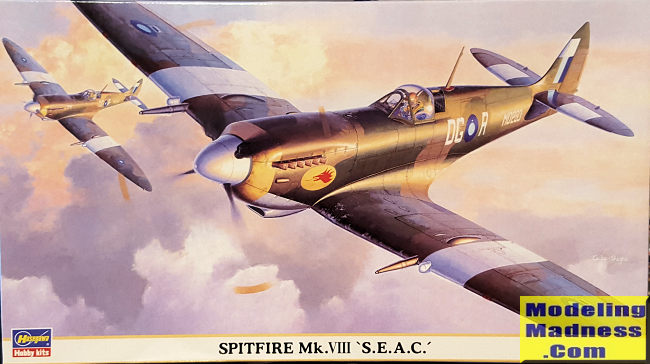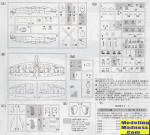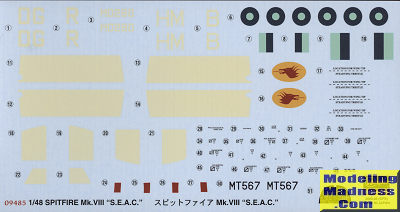
Hasegawa 1/48 Spitfire VIII 'S.E.A.C.'
| KIT #: | 09485 |
| PRICE: | 2400 yen SRP |
| DECALS: | Two options |
| REVIEWER: | Scott Van Aken |
| NOTES: | 2003 Limited Edition |

| HISTORY |
The Mk VIII was an adaptation of the Mk VII without the pressurised cabin and was intended to become the main production model of the Spitfire. When the "interim" Mk IX proved itself to be adequate for the RAF it was decided to use the shadow factory at Castle Bromwich to produce that version only: the Mk VIII Spitfires were all built by Supermarine.
Apart from the lack of pressurisation, the Mk VIII differed little from the Mk VII. Some early production models had extended wingtips but the majority were fitted with the standard version; according to Supermarine's Chief Test pilot Jeffrey Quill "When I am asked which mark of Spitfire I consider the best from the flying point of view, I usually reply 'The Mark VIII with standard wingtips.' I hated the extended wingtips...They were of no practical value to the Mark VIII and simply reduced the aileron response and the rate of roll." There were three sub-variants for low altitude (LF Mk VIII), medium altitude (F Mk VIII) and high altitude (HF Mk VIII) which were powered respectively by the Merlin 66, Merlin 63 and Merlin 70 engines.
The F Mk VIII's top speed was 408 mph (657 km/h) at 25,000 ft (404 mph for the LF Mk VIII at 21,000 ft (6,400 m) and 416 mph (669 km/h) for the HF Mk VIII at 26,500 ft), with a service ceiling of 43,000 ft (41,500 ft for the LF Mk VIII and 44,000 ft (13,000 m) for the HF Mk VIII). The two main tanks were given an extra 11 gal for a total of 96 gal which, along with the wing tanks, allowed the fighter to fly for a maximum distance of 660 mi (1,060 km) with a full internal fuel load and 1,180 miles (1,900 km) with a full internal load and a 90 gal drop tank. Provision was made to allow the Mk VIII to carry a single "slipper" drop tank of 30, 90 or 170 gal capacity. With a 170 gal tank, the aeroplane could fly over 1,500 mi (2,400 km). When carrying the 90 or 175 gal tank the aircraft was restricted, once airborne and at cruising altitude, to straight and level flight. A maximum external bomb load of 1,000 pounds (1 × 500 lb (230 kg) bomb attached to the centre bomb-rack plus a 250 lb (110 kg) bomb under each wing) could be carried.
A Mk VIII JF299 was used to experiment with the use of a new cut-back rear fuselage and a "tear-drop" canopy. This was intended to aid pilot visibility; many Spitfire pilots who were shot down were done so by enemies who approached in the aircraft's blind spot. In trials, the new hood design was found to bring about great improvements to all-round visibility and with several modifications, was standardised on later Spitfires.
This variant served almost exclusively overseas in the Mediterranean, with the Desert Air Force and the USAAF, in the South West Pacific Area, with the Royal Australian Air Force and RAF and in the South-East Asian theatre with the RAF. After the Mk IX and Mk V, the Mk VIII was the third most numerous operational variant with 1,658 examples built.
| THE KIT |
 Hasegawa's
1/48 Spitfire line was first released in the Mk.V form in 1993. The base boxing
for the Mk.VIII/IX was released in 2001. The molding of the kit is fully up to
Hasegawa's standards (which is quite high). However, somehow, Hasegawa make a
measuring glitch and the fuselage ended up being about 4mm too short. As usual,
this created an outcry amongst the most vocal part of our hobby. The rest of us
noted this and either spent more money on a replacement fuselage, or ignored it.
Hasegawa's
1/48 Spitfire line was first released in the Mk.V form in 1993. The base boxing
for the Mk.VIII/IX was released in 2001. The molding of the kit is fully up to
Hasegawa's standards (which is quite high). However, somehow, Hasegawa make a
measuring glitch and the fuselage ended up being about 4mm too short. As usual,
this created an outcry amongst the most vocal part of our hobby. The rest of us
noted this and either spent more money on a replacement fuselage, or ignored it.
The interior is nicely done with the floor molded in with a curved undersection, where some other kits will do these parts separately. As is normal, you are provided a decal for the instrument panel or you can paint the raised detail. There are also a lot of additional bits to attach to the sidewalls. The kit also includes the seat armor plate, something missed, by a few other kits.
One of the main visual clues between the VIII and IX is a retractable tail wheel. There is an insert for this and both types are included on the sprues. There are also inserts for the upper wing canon bulges. Holes in the lower wings can be opened to place bomb racks and bombs are provided. You also get the larger rudder for the VIII though the smaller one is also on the sprues. Wing tips are separate with the VIII using the larger ones, but the short versions often used on the IX are also on the sprues.
 Instructions
are standard fare with Gunze paint references. Both markings options have the
same camouflage scheme as shown on the box art plane. The box art aircraft is
with 155 Squadron and has the white stripes on the wings and tail. The other
one, from 136 Squadron does not have the white bands. Personally, I'd paint the
bands as the white in the decal sheet is off white. mpeter 109 and a tropical filter from one of Hasegawa’s
offerings.
Instructions
are standard fare with Gunze paint references. Both markings options have the
same camouflage scheme as shown on the box art plane. The box art aircraft is
with 155 Squadron and has the white stripes on the wings and tail. The other
one, from 136 Squadron does not have the white bands. Personally, I'd paint the
bands as the white in the decal sheet is off white. mpeter 109 and a tropical filter from one of Hasegawa’s
offerings.
| CONCLUSIONS |
With the release of the Eduard Spitfires, many modelers have gravitated to that kit. However, the Hasegawa kit is a known quantity and, from most reports, is not as fiddly as the Eduard offering (which I have not built). They are available on the second hand market and if you want a nice model for your shelf, this would be a good choice.
| REFERENCES |
https://en.wikipedia.org/wiki/Supermarine_Spitfire_(late_Merlin-powered_variants)
May 2020
Copyright ModelingMadness.com. All rights reserved
If you would like your product reviewed fairly and fairly quickly, please contact the editor or see other details in the Note to Contributors.
Back to the Main Page Back to the Review Index Page Back to the Previews Index Page